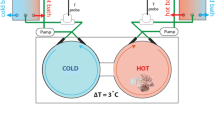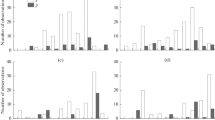Synopsis
The sand goby from the Oslofjord, Norway, is extremely eurythermal. In spring and autumn it avoids temperatures lower than about 4° C, in summer 6° C. Acclimation did not influence the lower avoidance temperature, but the critical thermal maximum, the upper avoidance temperature and the temperature where the whole fish darkened (the darkening temperature) varied with acclimation and season. The darkening temperature is suggested to be the upper temperature limit with the greatest ecological significance. The fish, collected at different seasons darkened at between 19.5 and 22° C. In the field the fish is not found at 20° C and higher.
The preference temperature varied with season and with acclimation temperature, generally with low precision. In May, the preference temperature was 13.5° C, that is higher than the ambient temperature of 10° C. In summer, the temperature in sampling locality and preference temperature was the same, 17 and 16.5° C respectively. In October, temperature preference was 7.5° C as compared to 9° C in the field. The variation is explained as a behavioural thermoregulation to direct the fish towards optimal conditions at any time.
The seasonal variation in preference temperature can not be ascribed only to seasonal variation in temperature, that is an acclimation phenomenon, but other factors are operative as well, factors which will modify the temperature tolerance in the fish.
Similar content being viewed by others
References cited
Cherry, D. S., K. L. Dickson & J. Cairns, Jr. 1975. Temperatures selected and avoided by fish at various acclimation temperatures. J. Fish. Res. Board Can. 32: 485–491.
Cocking, A. W. 1959. The effects of high temperatures on roach (Rutilus rutilis). I. The effects of constant high temperatures. J. exp. Biol. 36: 203–226.
Coutant, C. C. 1977. Compilation of temperature preference data. J. Fish. Res. Board Can. 34: 739–745.
De Vlaming, V. L. 1971. Thermal selection behaviour in the estuarine gobyGillichthys mirabilis Cooper. J. Fish Biol. 3: 277–286.
Doudoroff, P. 1938. Reactions of marine fishes to temperature gradients. Biol. Bull. 75: 494–509.
Ferguson, R. G. 1958. The preferred temperature of fish and their midsummer distributions in temperate lakes and streams. J. Fish. Res. Board Can. 15: 607–624.
Fry, F. E. J. 1947. Effects of the environment on animal activity. University of Toronto Studies, Biol. Ser. 55: 1–62.
Fry, F. E. J. 1958. The experimental study of behaviour in fish. Proc. Indo-Pacific Fish. Counc. 3: 37–42.
Fry, F. E. J. & J. S. Hart 1948. Cruising speed of goldfish in relation to water temperature. J. Fish. Res. Board Can. 7: 169–175.
Garside, E. T., D. G. Heinze & S. E. Barbour 1977. Thermal preferance in relation to salinity in the threespined stickleback,Gasterosteus aculeatus L., with an interpretation of its significance. Can. J. Zool. 55: 590–594.
Gibson, R. N. 1969. The biology and behaviour of littoral fish. Oceanogr. mar. Biol. 7: 367–410.
Hesthagen, I. H. 1975. Seasonal occurrence and length variation in the sand goby,Pomatoschistus minutus (Pallas), in the shore zone of the inner Oslofjord. Norw. J. Zool. 23: 235–242.
Hesthagen, I. H. 1977. Migrations, breeding, and growth inPomatoschistus minutus (Pallas) (Pisces, Gobiidae) in Oslofjorden, Norway. Sarsia 63: 17–26.
Javaid, M. Y. & J. M. Anderson 1967. Thermal acclimation and temperature selection in Atlantic salmon,Salmo salar, and rainbow trout,S. gairdneri. J. Fish. Res. Board Can. 24: 1507–1523.
Jones, F. R. H. 1956. The behaviour of minnows in relation to light intensity. J. exp. Biol. 33: 271–281.
Lagler, K. F., J. E. Bardach, R. R. Miller & D. R. M. Passino 1977. Ichthyology. 2. ed. John Wiley & Sons, New York. 506 pp.
McCauley, R. W. 1977. Laboratory methods for determining temperature preference. J. Fish. Res. Board Can. 34: 749–752.
Nilsen, G. B. & K. H. Røed 1978. A new aquarium for the study of temperature behaviour of fish. Sarsia 63: 199–202.
Otto, R. G. & J. O. Rice 1977. Responses of a freshwater sculpin (Cottus cognatus gracilis) to temperature. Trans. Amer. Fish. Soc. 106: 89–94.
Pye, J. D. 1964 a. Nervous control of chromatophores in teleost fishes. III. Local temperature responses in the minnow (Phoxinus phoxinus (L.)). J. exp. Biol. 41: 543–551.
Pye, J. D. 1964 b. Nervous control of chromatophores in teleost fishes. IV. A comparative survey of local temperature responses. J. exp. Biol. 41: 553–557.
Reynolds, W. W. 1977. Temperature as a proximate factor in orientation behaviour. J. Fish. Res. Board Can. 34: 734–739.
Richards, F. P., W. W. Reynolds & R. W. McCauley 1977. Temperature preference studies in environmental impact assessments: an overview with procedural recommendations. J. Fish. Res. Board Can. 34: 728–761.
Røed, K. H. 1979. The temperature preference of the threespined stickleback,Gasterosteus aculeatus L. (Pisces), collected at different seasons. Sarsia 64: 137–141.
Sullivan, C.M. & K.C. Fisher 1953. Seasonal fluctuations in the selected temperature of the speckled trout,Salvelinus fontinalis (Mitchill). J. Fish. Res. Board Can. 10: 187–195.
Wheeler, A. 1969. The fishes of the British Isles and NorthWest Europe. MacMillan, London. 613 pp.
Zahn, M. 1964. Jahreszeitliche Veränderungen der Vorzugs-temperaturen von Scholle (Pleuronectes platessa Linne) und Bitterling (Rhodeus sericeus Pallas). Zool. Anz. 27 (Suppl.): 562–580.
Author information
Authors and Affiliations
Rights and permissions
About this article
Cite this article
Hesthagen, I.H. Temperature selection and avoidance in the sand goby,Pomatoschistus minutus (Pallas), collected at different seasons. Environ Biol Fish 4, 369–377 (1979). https://doi.org/10.1007/BF00005526
Received:
Accepted:
Issue Date:
DOI: https://doi.org/10.1007/BF00005526




